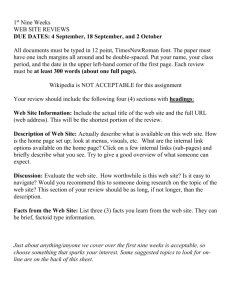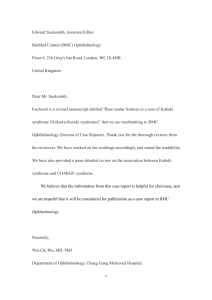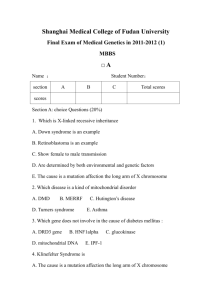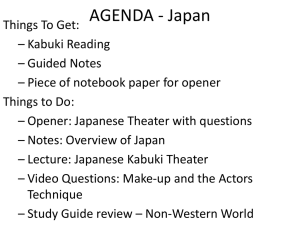Response Letter - BioMed Central
advertisement
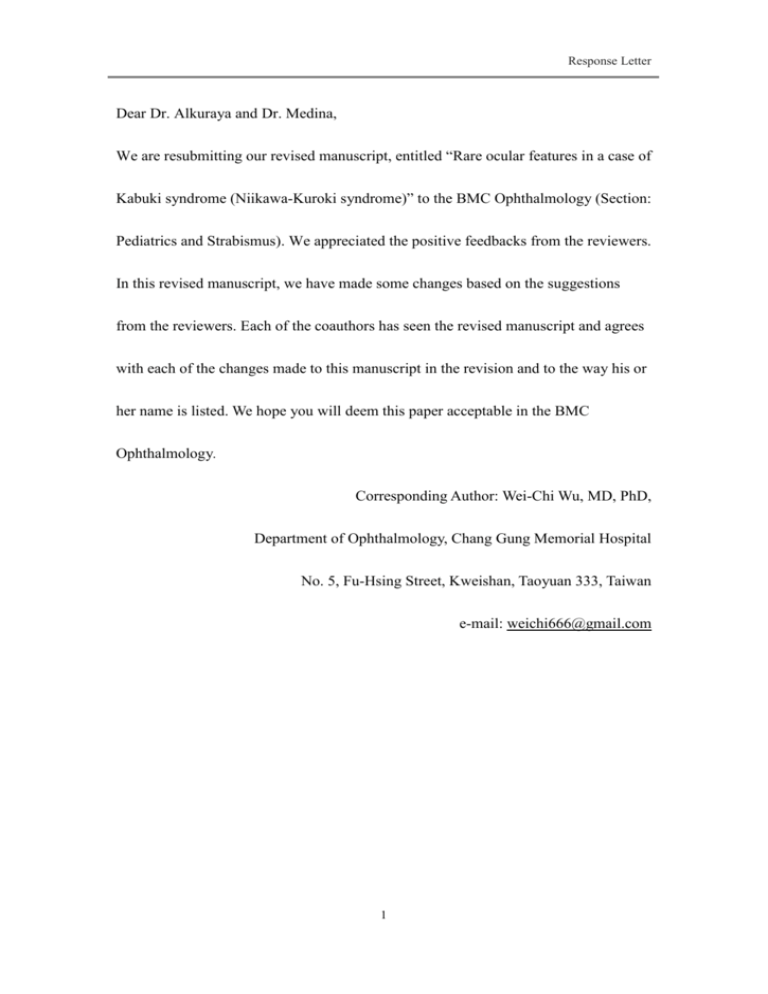
Response Letter Dear Dr. Alkuraya and Dr. Medina, We are resubmitting our revised manuscript, entitled “Rare ocular features in a case of Kabuki syndrome (Niikawa-Kuroki syndrome)” to the BMC Ophthalmology (Section: Pediatrics and Strabismus). We appreciated the positive feedbacks from the reviewers. In this revised manuscript, we have made some changes based on the suggestions from the reviewers. Each of the coauthors has seen the revised manuscript and agrees with each of the changes made to this manuscript in the revision and to the way his or her name is listed. We hope you will deem this paper acceptable in the BMC Ophthalmology. Corresponding Author: Wei-Chi Wu, MD, PhD, Department of Ophthalmology, Chang Gung Memorial Hospital No. 5, Fu-Hsing Street, Kweishan, Taoyuan 333, Taiwan e-mail: weichi666@gmail.com 1 Response Letter Reviewer- Flavio Medina 1. In the second paragraph of case report, authors describe patient fundus as retina and choroid coloboma in both eyes, optic disc coloboma in the right eye, and an elevated optic disc without central cupping in the left eye. We notice a bilateral posterior bulging in orbit CT. Could this left eye optic disc aspect be related to a peripapillary stafiloma, or to the colobomatous defect itself? Response: The computed tomography of the orbit revealed microophthalmos in the right eye and an isodense retrobulbar bulging cystic mass in both eyes. The defect is likely to be related to the colobomatous defect which was presented in Figure 1B and 1C in both eyes. We have changed the texts. (Please see changes in Page. 5, paragraph 2, line 13-16 and in Figure legends in Page. 12) 2. In the third paragraph of case report, authors mention that a diagnosis of Kabuki syndrome was made after a genetic examination. Should not diagnostic criteria for Kabuki syndrome rely on the clinical observation of 5 cardinal findings ? Response: The diagnosis of Kabuki syndrome was made on clinical observations. The genetic examinations were to confirm whether the patient has a MLL2 gene mutation. 2 Response Letter We have changed the wordings. (Please see changes in Page. 6, paragraph 2, line 1-5) 3. Consider inserting a discussion section and moving part of conclusion section to it. Response: We have inserted a Discussion section and moved part of the Conclusions to it as the reviewer suggested. (Please see changes in Page. 6-7) Reviewer- Fowzan Alkuraya 1. Please shift the focus of the paper to focus on the interesting overlap between Kabuki and CHARGE syndromes when the very rare finding of colobomatous microphthalmia in Kabuki syndrome is observed. This will also allow the authors to come up with a much more significant conclusion for their paper than the one in the current version. Response: Thanks for the constructive suggestions from the reviewer. We have added a paragraph about the overlapping ophthalmic findings of Kabuki and CHARGE syndrome and discussed the colobomatous microphthalmia and genetic findings in our patient. (Please see changes in Page. 6, last line to Page. 7, paragraph 1) 2. What is the MLL2 gene mutation? Is it novel? Is it de novo? How did they 3 Response Letter conclude it is pathogenic? Response: The MLL2 gene mutation is a de novo mutation. In 2010, Ng et al. identified loss-of function mutations in the mixed lineage leukemia 2 (MLL2) gene in 9 out of 10 patients with Kabuki syndrome via a whole exome sequencing approach. Furthermore, they screened MLL2 in additional 43 Kabuki patients and discovered 33 distinct mutations. They confirmed that MLL2 gene is a causative pathogenic gene for Kabuki syndrome [1]. Till now, more than 150 distinct mutations have been characterized in patients with Kabuki syndrome [1-3]. References: [1] Ng SB, Bigham AW, Buckingham KJ, Hannibal MC, McMillin MJ, Gildersleeve HI, Beck AE, Tabor HK, Cooper GM, Mefford HC, Lee C, Turner EH, Smith JD, Rieder MJ, Yoshiura K, Matsumoto N, Ohta T, Niikawa N, Nickerson DA, Bamshad MJ, Shendure J: Exome sequencing identifies MLL2 mutations as a cause of Kabuki syndrome. Nat Genet 2010, 42:790-793. [2] Hannibal MC, Buckingham KJ, Ng SB, Ming JE, Beck AE, McMillin MJ, Gildersleeve HI, Bigham AW, Tabor HK, Mefford HC, Cook J, Yoshiura K, Matsumoto T, Matsumoto N, Miyake N, Tonoki H, Naritomi K, Kaname T, Nagai T, Ohashi H, Kurosawa K, Hou JW, Ohta T, Liang D, Sudo A, Morris CA, Banka S, Black GC, Clayton-Smith J, Nickerson DA, et al.: Spectrum of MLL2 4 Response Letter (ALR) mutations in 110 cases of Kabuki syndrome. Am J Med Genet A 2011, 155A:1511-1516. [3] Paulussen AD, Stegmann AP, Blok MJ, Tserpelis D, Posma-Velter C, Detisch Y, Smeets EE, Wagemans A, Schrander JJ, van den Boogaard MJ, van der Smagt J, van HA, Stolte-Dijkstra I, Kerstjens-Frederikse WS, Mancini GM, Wessels MW, Hennekam RC, Vreeburg M, Geraedts J, de Ravel T, Fryns JP, Smeets HJ, Devriendt K, Schrander-Stumpel CT: MLL2 mutation spectrum in 45 patients with Kabuki syndrome. Hum Mutat 2011, 32:E2018-E2025. 3. Please use the term intellectual disability instead of mental retardation. Response: We have change the term in to “intellectual disability” accordingly. (Please see changes throughout the manuscript) 4. The use of colobomatous microphthalmia in the key words is advised. Response: We have changed the key words into “colobomatous microphthalmia” accordingly. (Please see changes throughout the manuscript) 5. Change “Despite this, few reports have reported on the ocular findings that 5 Response Letter may affect vision” to “In addition, ocular findings, usually in the form of strabismus and ptosis, have been reported”. Response: The sentence was changed as suggested by the reviewer. (Please see Page. 4, paragraph 1, line 7-8) 6. Change “the boy claimed” to “the boy was claimed”. Response: We have changed the wordings to “the boy was claimed” as the suggestion from the reviewer. (Please see Page 5, paragraph 1, line 1) 7. I’m surprised the very obvious microphthalmia in the clinical photograph is not listed in the features observed on external examination. It is obvious without the need for examination under anesthesia. Response: The micropthalmia in the clinical photograph was observed on external eye examinations. We have changed the wordings in the descriptions accordingly. (Please see Page. 5, paragraph 2, line 2-5) 8. If a photo consent is available it will be helpful to show the full face. Response: We have asked the family to sign up for a consent form, however; a photo consent was not available. Therefore, the mouth part is blocked out in Figure 1A. 6 Response Letter (Please see Figure 1) 7


